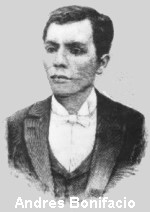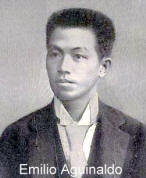|







| |
The Cry of Pugadlawin
 News
about the discovery of the Katipunan spread
to Manila and nearby suburbs, and Andres Bonifacio
immediately called for a general meeting. Various wings of the Katipunan gathered at the house of Juan Ramos
in Pugadlawin on August 23, 1896.
Ramos was the son of Melchora Aquino,
also known as “Tandang Sora” and was later acknowledged as the Mother of the
Katipunan." News
about the discovery of the Katipunan spread
to Manila and nearby suburbs, and Andres Bonifacio
immediately called for a general meeting. Various wings of the Katipunan gathered at the house of Juan Ramos
in Pugadlawin on August 23, 1896.
Ramos was the son of Melchora Aquino,
also known as “Tandang Sora” and was later acknowledged as the Mother of the
Katipunan."
Bonifacio asked his men whether they were willing to fight to the bitter end.
Everyone shouted their approval, except for Teodoro Plata, who though that it
was too soon for a revolution. Heartened by his men’s response, Bonifacio then
asked them to tear their cedulas (residence certificates) to pieces, as a sign
of their defiance and determination to rise against the
Spaniards. The men immediately tore
up their cedulas, shouting, Mabuhay ang Pilipinas (long live the
Philippines)
-known as the Cry of Pugadlawin.
The Katipunan in Cavite
Cavite soon became the center of the Revolution, and the Katipuneros there
divided themselves into the Magdalo and Magdiwang factions. Baldomero Aguinaldo,
brother of Emilio Aguinaldo, headed the Magdalo group, which was stationed in
Kawit. General Mariano Alvarez led the Magdiwang group, which was stationed in
Noveleta.
 The
two groups fought in separate battles. Emilio Aguinaldo overran
Kawit on August 31, 1896, while Alvarez attacked Noveleta. In Bacoor, Aguinaldo tried to
intercept Spanish reinforcements coming from Manila; but he was repulsed and
forced to retreat to nearby Imus. Here, on the morning of September 5, he
defeated the Spanish troops under the command of General Aguirre. A hundred
Spaniards were killed and 60 weapons were confiscated. Aguinaldo was hailed as a
hero. The adoring Caviteños referred to him as “General Miong” and no longer
“Kapitan Miong.” The
two groups fought in separate battles. Emilio Aguinaldo overran
Kawit on August 31, 1896, while Alvarez attacked Noveleta. In Bacoor, Aguinaldo tried to
intercept Spanish reinforcements coming from Manila; but he was repulsed and
forced to retreat to nearby Imus. Here, on the morning of September 5, he
defeated the Spanish troops under the command of General Aguirre. A hundred
Spaniards were killed and 60 weapons were confiscated. Aguinaldo was hailed as a
hero. The adoring Caviteños referred to him as “General Miong” and no longer
“Kapitan Miong.”
General Aguinaldo’s numerous victories in the battlefield made him the
acknowledged revolutionary leader in Cavite. He issued a proclamation on October
31, 1896 enjoining the people to take courage and continue fighting for
Philippine independence.
Owing to the defeat of the Spaniards in Cavite, Camilo de Polavieja replaced
Ramon Blanco as governor general on December 13, 1896. Polavieja was more
successful than his predecessor and slowly regained one-third of the province.
Andres Bonifacio's Execution
While Aguinaldo was
recognized as leader by the Magdalo faction, Bonifacio was recognized as the
leader of the Katipunan by the Magdiwang faction. An assembly was held in Imus,
Cavite on December 31, 1897 to settle the leadership issue but was not
successful. Then on March 22, another assembly was held at Tejeros (known as the
Tejeros Convention) to elect officers of the revolutionary government. Aguinaldo
won as president while Bonifacio was relegated as the Director of the Interior.
Bonifacio rejected the elections and declared it void. Bonifacio later formed
the Naic Military Agreement, essentially creating a government contending
Aguinaldo's. Soon after, Bonifacio was captured, stood trial, and was sentenced
to death by a War Council of Aguinaldo's government. Aguinaldo initially
commuted the sentence to deportation but later reversed the commutation upon
pressure from Pio Del Pilar and other officers. On orders from General Mariano
Noriel, Andres Bonifacio was executed at the foothills of Mt. Buntis by Major
Lazaro Makapagal on May 10, 1897.
The Revolution Continues
Bonifacio’s death did not deter the Filipinos from fighting for their freedom.
The Spanish government, for its part, doubled its efforts in trying to control
Cavite, which was considered the seat of the Revolution.
When Governor General Primo de Rivera replaced Camilo Polavieja on April 27, 1897, he
immediately marched to Naic, Cavite to persuade the Filipinos to surrender. The rebels,
however, stood their ground.
Aguinaldo realized that Cavite was no longer safe for his men. They moved to
Batangas, where they temporarily set up camp in the town of Talisay. However,
Spanish soldiers were able to pursue them there. Thus, they retreated to Morong
on June 10, 1897 and proceeded to Biak-na-Bato in Bulacan.
Click here to continue with Pact of Biak-na-Bato.
Back to Philippine History - Home Page
|